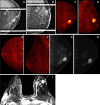Breast Cancer Detection Using a Low-Dose Positron Emission Digital Mammography System
- PMID: 38334470
- PMCID: PMC10988332
- DOI: 10.1148/rycan.230020
Breast Cancer Detection Using a Low-Dose Positron Emission Digital Mammography System
Abstract
Purpose To investigate the feasibility of low-dose positron emission mammography (PEM) concurrently to MRI to identify breast cancer and determine its local extent. Materials and Methods In this research ethics board-approved prospective study, participants newly diagnosed with breast cancer with concurrent breast MRI acquisitions were assigned independently of breast density, tumor size, and histopathologic cancer subtype to undergo low-dose PEM with up to 185 MBq of fluorine 18-labeled fluorodeoxyglucose (18F-FDG). Two breast radiologists, unaware of the cancer location, reviewed PEM images taken 1 and 4 hours following 18F-FDG injection. Findings were correlated with histopathologic results. Detection accuracy and participant details were examined using logistic regression and summary statistics, and a comparative analysis assessed the efficacy of PEM and MRI additional lesions detection (ClinicalTrials.gov: NCT03520218). Results Twenty-five female participants (median age, 52 years; range, 32-85 years) comprised the cohort. Twenty-four of 25 (96%) cancers (19 invasive cancers and five in situ diseases) were identified with PEM from 100 sets of bilateral images, showcasing comparable performance even after 3 hours of radiotracer uptake. The median invasive cancer size was 31 mm (range, 10-120). Three additional in situ grade 2 lesions were missed at PEM. While not significant, PEM detected fewer false-positive additional lesions compared with MRI (one of six [16%] vs eight of 13 [62%]; P = .14). Conclusion This study suggests the feasibility of a low-dose PEM system in helping to detect invasive breast cancer. Though large-scale clinical trials are essential to confirm these preliminary results, this study underscores the potential of this low-dose PEM system as a promising imaging tool in breast cancer diagnosis. ClinicalTrials.gov registration no. NCT03520218 Keywords: Positron Emission Digital Mammography, Invasive Breast Cancer, Oncology, MRI Supplemental material is available for this article. © RSNA, 2024 See also commentary by Barreto and Rapelyea in this issue.
Keywords: Invasive Breast Cancer; MRI; Oncology; Positron Emission Digital Mammography.
Conflict of interest statement
Figures





References
-
- Smith RA , Duffy SW , Gabe R , Tabar L , Yen AM , Chen TH . The randomized trials of breast cancer screening: what have we learned? Radiol Clin North Am 2004. ; 42 ( 5 ): 793 – 806 , v. - PubMed
-
- Kuhl CK , Strobel K , Bieling H , Leutner C , Schild HH , Schrading S . Supplemental Breast MR Imaging Screening of Women with Average Risk of Breast Cancer . Radiology 2017. ; 283 ( 2 ): 361 – 370 . - PubMed
MeSH terms
Substances
Associated data
LinkOut - more resources
Full Text Sources
Medical
Research Materials

